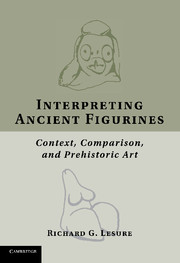Book contents
- Frontmatter
- Contents
- Figures and Tables
- Acknowledgments
- Introduction
- One Universalist Explanation and Prehistoric Figurines
- Two Comparison and Context
- Three The Questions We Ask of Images
- Four A Cross-Cultural Explanation for Female Figurines?
- Five Mesoamerican Figurines and the Contextualist Appeal to Universal Truths
- Six Figurines, Goddesses, and the Texture of Long-Term Structures in the Near East
- Seven On Figurines, Femaleness, and Comparison
- Notes
- Bibliography
- Index
Six - Figurines, Goddesses, and the Texture of Long-Term Structures in the Near East
Published online by Cambridge University Press: 01 March 2011
- Frontmatter
- Contents
- Figures and Tables
- Acknowledgments
- Introduction
- One Universalist Explanation and Prehistoric Figurines
- Two Comparison and Context
- Three The Questions We Ask of Images
- Four A Cross-Cultural Explanation for Female Figurines?
- Five Mesoamerican Figurines and the Contextualist Appeal to Universal Truths
- Six Figurines, Goddesses, and the Texture of Long-Term Structures in the Near East
- Seven On Figurines, Femaleness, and Comparison
- Notes
- Bibliography
- Index
Summary
With my extended attention to universalist logic, I have been ignoring the outcome of an initial encounter with universalism, the testing of Morss's agriculture-pottery-gynecomorph hypothesis in Chapter 1. That effort took us out from among the “trees” of prehistoric figurine making to give us a glimpse of the “forests.” Those proved large in spatiotemporal extension (macro-units) but few in number, with perhaps little in common – a possibility endorsed again in Chapter 4 in an assessment of the prospects for cross-cultural explanation of femaleness in figurines. Most of what there is to explain about figurines must be addressed at a scale no larger than the macro-unit. Although universalist logic still has a role (see Chapter 5), the comparative problem that emerges most clearly is the possibility that – vast spatial and temporal scales notwithstanding – the clustering of figurine-making traditions was the result of direct transmission of ideas between contexts. It is time, then, to consider comparison as a historicist problem.
In historicist explanations, an important analytical goal is to reveal how conditions in one context emerged understandably from antecedent conditions in another context separated from the first in time or space. One possibility for consideration is that continuities in figurine making are the result of the perpetuation of symbolic structures over many centuries, a truly longue durée. However, we face a challenge identified in Chapter 2: analytical essentialism.
- Type
- Chapter
- Information
- Interpreting Ancient FigurinesContext, Comparison, and Prehistoric Art, pp. 156 - 206Publisher: Cambridge University PressPrint publication year: 2011



